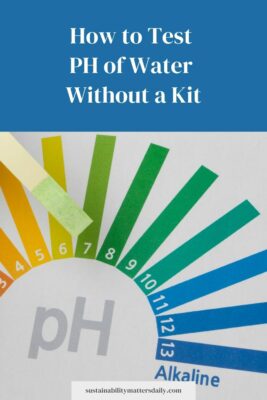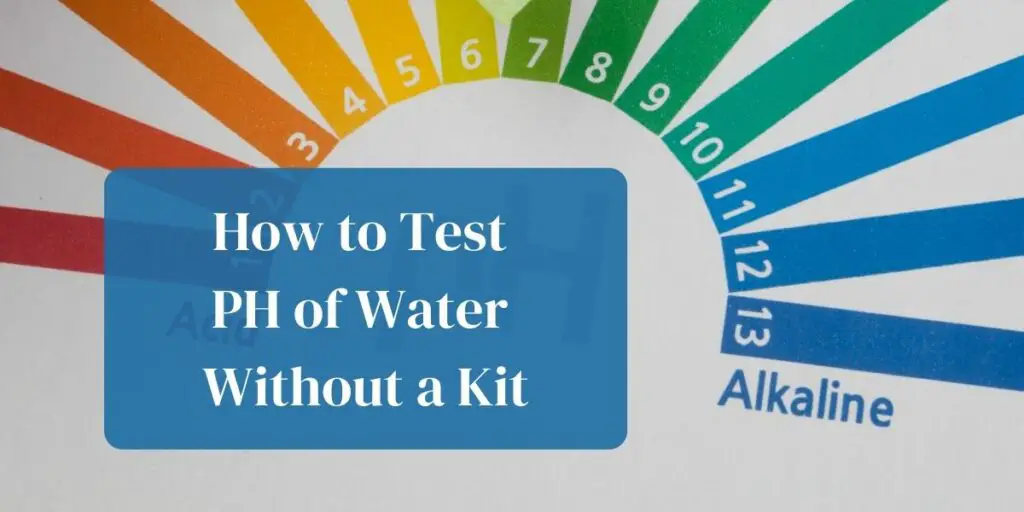It is possible to do a pH water without using a pH testing kit. Typically, a water pH kit will contain indicator drops, pH test strips, and a pH test meter. Let’s look at how to test the pH of water without a kit.
It’s as easy as buying a bottle of distilled water and red cabbage to make your pH indicator. A water-soluble pigment flavin found in cabbage will give it a red color.
It will only cost you to buy red cabbage and distilled water, and you can quickly test the pH levels and get prompt results that will be sufficient for several households. However, the test may not be accurate enough for testing products intended for commercial use.
In the modern world, you can quickly check the pH of water at home. By testing it, you can know if it is acidic or alkaline. Monitoring and keeping the pH value of water in your fish pond and tanks will help stabilize the growth of fish.
Note that fish can’t thrive on acidic or highly alkaline water.
Today, some drinking water brands will brand their products and include the pH value of on their labels. You can utilize the values to calibrate your pH meter from 0 to 14.

Table of Contents
- How to test pH of water without a kit: methods
- Other methods for testing the pH of water
- How does water become alkaline or acidic?
- How can you neutralize water pH
- All living organisms have a PH condition
- Conclusion
How to test pH of water without a kit: methods
1. Test the pH levels using a red cabbage
Grate or cut the red cabbage. Place it in a clear glass bowl. Use a separate post to boil about two cups of distilled water.
Once hot, pour it over the cabbage and make sure you just cover it. While using a wooden spoon for stirring, leave the mixture to settle for about 30 minutes.
A chemical reaction will take place, making the pigment to change color of distilled water. After that, strain the liquid that is already purplish. The liquid will act as your indicator solution.
Place a little amount of the water you are testing in a different clear glass or plastic clean container?add few drops of the indicator solution in the water you want to test.
The water color changes to show either acidic (red or pink), alkaline ( greenish-yellow), or neutral (purple) color measurement. Check the change color you get against the color chart and establish the numerical value matching the color on the pH scale.
Numbers on a pH scale scale range between 0 to 14. Pure water will have a pH value of 7, meaning it is neutral. Any number below 7 indicates acidic pH level, while numbers beyond seven will indicate an alkaline level.
Alternatively, you can try it out with other vegetables and fruits to develop a pH indicator solution. You can try using plums, red onion, blueberries, apple skins, and turmeric or petals from red roses.
Additionally, you can make the pH testing strips from a cabbage juice indicator. Using a filter paper or acidic-free art paper. Put the paper in the cabbage juice indicator you already have. Make sure you soak the paper until it is thoroughly wet.
Remove the paper and give it time to dry on a neutral environment free from alkaline condensation or acids. Once completely dry, cut the paper into strips. You can utilize a cotton swab for smearing a sample of the water you need to test on the testing strip. Then match the color of the piece to the pH color chart.
2. What household items be used to test PH?
The following household items can be used in testing:
- Coffee filters
- Cabbage juice
- Ceramic dish
- Cotton swabs
- Red onions
- Blueberries
- Plums
- Apple or grape skin
- Turmeric
- Baking soda
- Petals from red roses
Other methods for testing the pH of water
The following methods are applicable in testing the water
- Use of a litmus paper
- Use of a pH meter
- Use of pH test strips
- Using a universal indicator chart and a pH solution.
1. Test with a pH meter
The use of a digital meter is a more accurate way of testing if you water is acidic or basic. Testing your water reduces the chances of errors while testing it.
People will always see colors differently, and the person testing might not choose the right color. The meter will also remove any chance of contamination in case of mishandling the test strips, storage issues, or use of strips that are out of date that would affect the accuracy of your reading.
A pH meter is better since it doesn’t depend on color changes; instead, it measures the amount of acid in water once you dip the glass electrode in water.
It will show you the numerical pH value. To ascertain the value is right, you can verify the accuracy of the meter using an establish a pH substance before performing it. Once you confirm the meter, rinse the end with deionized water and dry it using a clean tissue or cloth.
Once you have put your test water in a small container, let it settle for a few minutes so that the temperature can stabilize. Noting that temperature affects the pH, it will be essential to determine the temperature of the water using a thermometer.
Compare the temperature with that of the default meter temperature, then input the water temperature into the meter. Place the probe into the water sample, ensuring it is completely covering the tip of the probe. Wait for a short moment for the meter reading to be stable.
Pure water has a pH of around 7. A pH of less than 7 shows acidic water, while alkaline or basic water will have a pH of more than 7.
Before using the pH probe and meter for testing the pH, you should test the meter in a substance that has a well-known pH rating to calibrate it. For instance, you know pure water has a pH of 7. If need be, adjust the meter accordingly. Before you do the pH test, ensure you rinse the probe and meter in clean water and wipe it dry with a tissue.
Ensure you put the liquid to be tested in a clean container that is big enough to cover the tip of the probe. Using a thermometer, check the temperature of the sample liquid and adjust the meter so that it matches the sample temperature.
This will be a vital step since temperature affects the sensitivity of the probe. Place the probe in the sample and wait for the measurement to get steady, which shows the meter has reached the equilibrium. You can now readily record the pH value of your sample.
- 【How to use calibration】Press CAL for 5 seconds to enter the calibration mode, press in turn to select the powders corresponding to 6.86, 4, and 9.18 to complete the calibration.
- 【Mini Size】The mini size ph meter we designed allows you to easily put it in your pocket, so you can take measurements anytime, anywhere. It can help you test it whether you take it to the pool, on a trip, to the beach or camping.
- 【Family Essentials】As a tool to improve the quality of life. Can be used to test drinking water, swimming pools, PH balance in aquarium, RO system, spa or hydroponics. Basically all the environments that need to test PH value can use this tester to get accurate data.
- 【Easy to use】turn on the switch,put the probe into the water and stir (make the small glass ball fully contact the liquid) and the value can be read when the value is stable.
- 【Automatic temperature compensation】There is no need to care about the temperature of the liquid being measured. The PH meter has an automatic temperature compensation function, which can be adjusted according to the water temperature and water quality.
Testing water pH using a pH meter
Several brands of pH meter are available in the market, which would help test the pH of your water at home. This is how to do it.
- Put about 100 ml of the water you want to test in a glass.
- Place the pH meter in the glass for about one minute.
- You will see the pH value of water on the pH meter display.
- Since this is a piece of electronic equipment, you will need to check and correct pH meter reading at regular intervals.
Calibration powder and water with the right pH value printed on the labels can be useful while calibrating the meter. Most of the pH meter will give you a calibration powder along with its package.
2. Using a universal indicator chart and PH solution to test the water
You can quickly test it using a universal indicator chart and a pH solution. You can quickly obtain a pH solution from online shops or nearby aquarium shops. Using the color value, you can identify the pH value.
- Put about 10 ml of the water you want to test in a small glass container.
- Add five drops of pH solution to the water in the container
- Ensure the solution is thoroughly mixed with water
- Compare the test tube color with that of the color strip and get the water pH value.
- Empty and clean the test tube for future use.
You can easily test the pH of water in your pet fish tank or aquarium using this method.
Related
3. Testing the pH value using a litmus paper
It is an ancient way of testing water to find its pH, although many people are still using it. Even though it doesn’t give very accurate value, you can easily determine if the water is alkaline, neutral, or acidic.
Procedure:
- Get a red and a blue strip
- Put the strip in the water you want to test
- In case the water is alkaline, the red litmus paper turns blue while the red litmus paper won’t change.
- If the water is neutral, there will be no color change in either the red or the blue paper.
The pH testing strips come with a series of indicator bar which changes the color with change after exposure to a given solution. Also, note that the strength of the bases and acids on every bar will differ. Get your sample liquid and put it in a container while making sure the sample is deep to cover the testing strip.
Dip it into the sample for a little time until the bars on the paper change the color. Match the tip of your test strip with the color of the chart that comes with the paper to identify the pH level of the liquid.
Choosing the right kind of testing kit
Litmus papers you purchase gives only either acidic or alkaline response. The litmus paper comes in blue or red. The red litmus paper will change color to blue if the water is base or alkaline, while a blue litmus paper turns red in acidic water. In case the water is pure, on a neutral pH of 7, the color of the litmus paper won’t change.
Using a pH testing kit will be more accurate, unlike the litmus paper. The pH testing kit will give a more accurate result that clearly defines the level of acidic or basic of a particular substance. Put the pH testing strip in a glass tube or plastic.
Add the water you are testing to cover the pH test strip. After a short moment, remove the test strip and compare the color to that on the pH color chart.
The testing strip will need to be kept dry at room temperature. The expiration of the strips will always be shown on the color chart, usually 3-6 weeks.
How does water become alkaline or acidic?
Water with neutral pH has a better taste. It is not only healthy for consumption but also your household items. Contamination by pesticides, acid rain, and minerals from rocks as well as metal leaching from pipes affects the pH of water. Depending on the pH level, the alkaline water might have a bitter taste and also cause corrosion on your pipes.
Water with a pH value above nine will corrode zinc, copper, iron, and brass too. That explains why you find deposits on your dishes and have difficulty using soup with hard alkaline water. Acidic water will have a sour taste.
If your water has a pH value below 6.5, it is likely to have toxic levels of metals, including manganese and iron. Also, pipe breakdown can result from acidic water and leach metals from your pipes. You can even notice stains that are bluish on your laundry.
How can you neutralize water pH
Acidic substances are used to neutralize base alkaline water, while alkaline substances are used to neutralize the acidic water. Here are some of the ways to neutralize the pH of water at your home.
Place a filter at the point where water enters your home. Use calcium carbonate to neutralize alkaline water. Also, magnesium oxide is a substance used to neutralize acidic water.
You can install an injection system at the point where water enters your home. Soda ash is effective in neutralizing acidic water. Also, acetic acid like the one found in vinegar, alum, or citric acid can be used to neutralize high alkaline levels of water. However, the injection system will require intense maintenance, unlike a filtering system.
A water distillation system is useful in neutralizing the acidic pH for your drinking water. The distillers will heat and eliminate any acidic particles and form steam, free from the acid.
Utilization of electrolysis method in a water ionizer system. It is useful in separating acidic and alkaline parts of water. The alkaline water is healthy for drinking while the acidic water can be used for cleaning and washing. Ionizers are expensive, unlike the neutralizing solutions and neutralizing filters.
All living organisms have a PH condition
Everything, including your body and the saliva in your mouth, has a pH value. Note that the health of gums and teeth can be affected by the pH of your saliva. At a pH level of 5.5 or below, the production of bacteria in your mouth would result in tooth decay. The same applies to your entire body.
So it is worth endeavoring to drink water that is pure or close to pure as much as you can. While eating acidic foods, take a few sips of pure water to rinse the acid from your mouth. You can rinse your mouth with soda water, then rinse it using pure water.
Conclusion
You can do phtest of water at home easily using the above methods without using a kit. Ensure that you calibrate the pH meter at regular intervals to obtain a perfect reading. Using either of the above methods to check the pH value will help ensure the pH are the same and accurate.
You can apply lime treatment to raise the pH of the water. You can also reduce the pH of the water using a light acid such as vinegar.




It is simple to learn how to test the pH of water without a kit. Almost any other anthocyanin-rich food you have in your kitchen can be used as a pH meter.